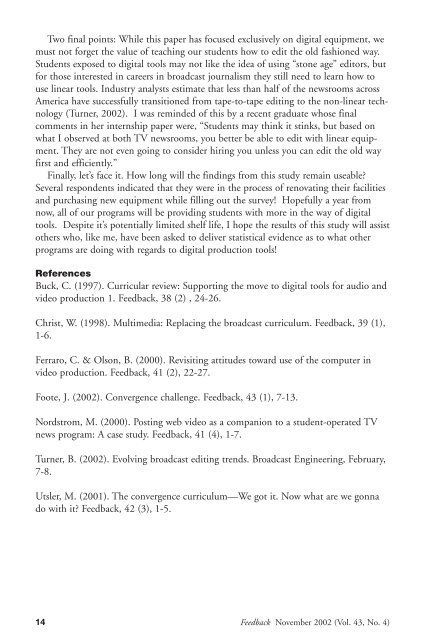Feedback November 2002 (Vol 43 No 4)
Feedback November 2002 (Vol. 43, No. 4) - Broadcast Education ...
Feedback November 2002 (Vol. 43, No. 4) - Broadcast Education ...
You also want an ePaper? Increase the reach of your titles
YUMPU automatically turns print PDFs into web optimized ePapers that Google loves.
Two final points: While this paper has focused exclusively on digital equipment, wemust not forget the value of teaching our students how to edit the old fashioned way.Students exposed to digital tools may not like the idea of using “stone age” editors, butfor those interested in careers in broadcast journalism they still need to learn how touse linear tools. Industry analysts estimate that less than half of the newsrooms acrossAmerica have successfully transitioned from tape-to-tape editing to the non-linear technology(Turner, <strong>2002</strong>). I was reminded of this by a recent graduate whose finalcomments in her internship paper were, “Students may think it stinks, but based onwhat I observed at both TV newsrooms, you better be able to edit with linear equipment.They are not even going to consider hiring you unless you can edit the old wayfirst and efficiently.”Finally, let’s face it. How long will the findings from this study remain useable?Several respondents indicated that they were in the process of renovating their facilitiesand purchasing new equipment while filling out the survey! Hopefully a year fromnow, all of our programs will be providing students with more in the way of digitaltools. Despite it’s potentially limited shelf life, I hope the results of this study will assistothers who, like me, have been asked to deliver statistical evidence as to what otherprograms are doing with regards to digital production tools!ReferencesBuck, C. (1997). Curricular review: Supporting the move to digital tools for audio andvideo production 1. <strong>Feedback</strong>, 38 (2) , 24-26.Christ, W. (1998). Multimedia: Replacing the broadcast curriculum. <strong>Feedback</strong>, 39 (1),1-6.Ferraro, C. & Olson, B. (2000). Revisiting attitudes toward use of the computer invideo production. <strong>Feedback</strong>, 41 (2), 22-27.Foote, J. (<strong>2002</strong>). Convergence challenge. <strong>Feedback</strong>, <strong>43</strong> (1), 7-13.<strong>No</strong>rdstrom, M. (2000). Posting web video as a companion to a student-operated TVnews program: A case study. <strong>Feedback</strong>, 41 (4), 1-7.Turner, B. (<strong>2002</strong>). Evolving broadcast editing trends. Broadcast Engineering, February,7-8.Utsler, M. (2001). The convergence curriculum—We got it. <strong>No</strong>w what are we gonnado with it? <strong>Feedback</strong>, 42 (3), 1-5.14<strong>Feedback</strong> <strong><strong>No</strong>vember</strong> <strong>2002</strong> (<strong>Vol</strong>. <strong>43</strong>, <strong>No</strong>. 4)
















